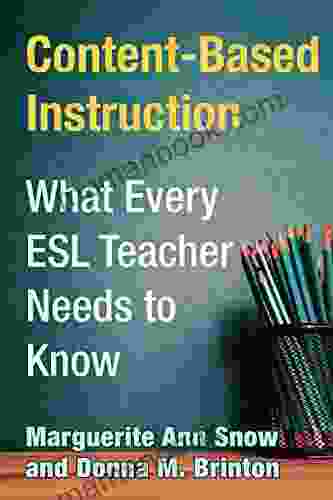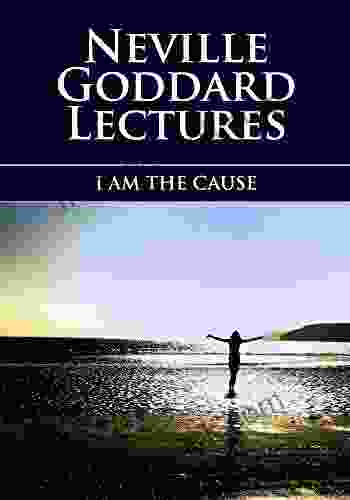What Every ESL Teacher Needs to Know: A Comprehensive Guide

Teaching English as a Second Language (ESL) requires a unique set of skills and knowledge. Whether you're a seasoned veteran or just starting out, it's essential to stay informed about the latest trends and best practices in ESL teaching.
1. Understanding the Learner's Needs
The most important aspect of ESL teaching is understanding the needs of your students. This includes their:
5 out of 5
| Language | : | English |
| File size | : | 960 KB |
| Text-to-Speech | : | Enabled |
| Screen Reader | : | Supported |
| Enhanced typesetting | : | Enabled |
| Word Wise | : | Enabled |
| Print length | : | 62 pages |
- Language level
- Learning goals
- Cultural background
- Learning styles
Tailor your lessons to meet the specific needs of your students. Consider their language proficiency, learning objectives, cultural background, and individual learning preferences.
2. Effective Teaching Methods
There are numerous teaching methods and techniques available for ESL teachers. Some of the most effective include:
- The Communicative Approach: Focuses on developing students' communicative competence and real-world language skills.
- Task-Based Learning: Involves engaging students in authentic tasks that require them to use language meaningfully.
- Content-Based Instruction: Teaches language through the context of a subject matter, such as history or science.
- Technology-Enhanced Learning: Utilizes technology and online resources to enhance student learning.
Choose the methods that best align with your students' needs and learning styles.
3. Assessment and Evaluation
Regular assessment is crucial for monitoring student progress and identifying areas for improvement. Utilize a variety of assessment tools, such as:
- Formative assessments (e.g., quizzes, class participation)
- Summative assessments (e.g., tests, portfolios)
- Self-assessments
- Peer assessments
Provide students with timely and constructive feedback to help them improve.
4. Cultural Awareness
Understanding the cultural backgrounds of your students is essential for effective ESL teaching. This includes their:
- Values and beliefs
- Customs and traditions
- Communication styles
Cultural awareness helps you create a welcoming and inclusive learning environment, bridge cultural gaps, and avoid misunderstandings.
5. Language Proficiency
As an ESL teacher, it's crucial to have a strong command of both English and your students' native languages. This enables you to:
- Communicate effectively with students
- Provide clear and accurate explanations
- Understand and address students' linguistic challenges
Continuously improve your language proficiency through professional development and language immersion.
6. Professional Development
Stay up-to-date on the latest developments in ESL teaching by engaging in ongoing professional development. This includes:
- Attending workshops and conferences
- Reading professional journals and books
- Collaborating with other ESL teachers
Professional development helps you refine your skills, stay informed about new methodologies, and improve the overall quality of your teaching.
7. Resources and Materials
Having access to high-quality resources and materials is essential for successful ESL teaching. This includes:
- Textbooks and course materials
- Authentic texts (e.g., articles, videos, podcasts)
- Supplemental activities and exercises
- Technology tools and apps
Provide your students with a variety of resources that cater to their diverse learning needs and make learning engaging and interactive.
8. Classroom Management
Effective ESL teaching requires strong classroom management skills. This includes:
- Establishing rules and expectations
- Creating a positive and supportive learning environment
- Managing student interactions
- Addressing disruptive behavior
Effective classroom management ensures a productive and enjoyable learning atmosphere.
9. Reflection and Improvement
Continuously reflect on your teaching practices and seek areas for improvement. This includes asking yourself:
- What are my students learning?
- What areas need more attention?
- How can I improve the quality of my lessons?
Seek feedback from colleagues, students, and supervisors to gain valuable insights and enhance your teaching.
Teaching ESL requires a multifaceted blend of skills, knowledge, and professionalism. By embracing these essential principles, you can create a dynamic and effective learning environment for your students, fostering their language acquisition and cross-cultural understanding.
Remember, ESL teaching is an ongoing journey of learning, growth, and collaboration. As you continue to develop your skills and knowledge, you'll become an indispensable asset to your students and the field of education.
5 out of 5
| Language | : | English |
| File size | : | 960 KB |
| Text-to-Speech | : | Enabled |
| Screen Reader | : | Supported |
| Enhanced typesetting | : | Enabled |
| Word Wise | : | Enabled |
| Print length | : | 62 pages |
Do you want to contribute by writing guest posts on this blog?
Please contact us and send us a resume of previous articles that you have written.
 Top Book
Top Book Novel
Novel Fiction
Fiction Nonfiction
Nonfiction Literature
Literature Paperback
Paperback Hardcover
Hardcover E-book
E-book Audiobook
Audiobook Bestseller
Bestseller Classic
Classic Mystery
Mystery Thriller
Thriller Romance
Romance Fantasy
Fantasy Science Fiction
Science Fiction Biography
Biography Memoir
Memoir Autobiography
Autobiography Poetry
Poetry Drama
Drama Historical Fiction
Historical Fiction Self-help
Self-help Young Adult
Young Adult Childrens Books
Childrens Books Graphic Novel
Graphic Novel Anthology
Anthology Series
Series Encyclopedia
Encyclopedia Reference
Reference Guidebook
Guidebook Textbook
Textbook Workbook
Workbook Journal
Journal Diary
Diary Manuscript
Manuscript Folio
Folio Pulp Fiction
Pulp Fiction Short Stories
Short Stories Fairy Tales
Fairy Tales Fables
Fables Mythology
Mythology Philosophy
Philosophy Religion
Religion Spirituality
Spirituality Essays
Essays Critique
Critique Commentary
Commentary Glossary
Glossary Bibliography
Bibliography Index
Index Table of Contents
Table of Contents Preface
Preface Introduction
Introduction Foreword
Foreword Afterword
Afterword Appendices
Appendices Annotations
Annotations Footnotes
Footnotes Epilogue
Epilogue Prologue
Prologue Kate Manne
Kate Manne Carl Sandburg
Carl Sandburg Jim Bryant
Jim Bryant Ed Rosenthal
Ed Rosenthal Douglas A Blackmon
Douglas A Blackmon Gus Garcia Roberts
Gus Garcia Roberts Pamela Grundy
Pamela Grundy Matt Forbeck
Matt Forbeck Joann Klusmeyer
Joann Klusmeyer Em Petrova
Em Petrova Danielle Duckery
Danielle Duckery Jinx Schwartz
Jinx Schwartz Paul A Craig
Paul A Craig Carter Godwin Woodson
Carter Godwin Woodson John Locke
John Locke The Brothers Rodemeyer
The Brothers Rodemeyer Svingen And Pedersen
Svingen And Pedersen Nadia Eghbal
Nadia Eghbal D Lulu
D Lulu Kurt Vonnegut
Kurt Vonnegut
Light bulbAdvertise smarter! Our strategic ad space ensures maximum exposure. Reserve your spot today!

 Robert Louis StevensonBrigade Exchange Carl Sandburg: Your One-Stop Destination for Military...
Robert Louis StevensonBrigade Exchange Carl Sandburg: Your One-Stop Destination for Military...
 Dwayne MitchellThe Ultimate Guide to Moms On Call Basic Baby Care Months Parenting of Moms...
Dwayne MitchellThe Ultimate Guide to Moms On Call Basic Baby Care Months Parenting of Moms... Holden BellFollow ·18.7k
Holden BellFollow ·18.7k Felipe BlairFollow ·19.9k
Felipe BlairFollow ·19.9k Ken SimmonsFollow ·16.3k
Ken SimmonsFollow ·16.3k Victor HugoFollow ·14.8k
Victor HugoFollow ·14.8k Drew BellFollow ·9.9k
Drew BellFollow ·9.9k Herman MelvilleFollow ·17.1k
Herman MelvilleFollow ·17.1k Maurice ParkerFollow ·15.8k
Maurice ParkerFollow ·15.8k Ricky BellFollow ·5.9k
Ricky BellFollow ·5.9k

 Ernest Powell
Ernest PowellBenefits of Corporal Punishment: A Review of the...
Corporal punishment is a form of physical...

 Bobby Howard
Bobby HowardThe Development and Significance of African American...
African American...

 Guy Powell
Guy PowellDown Girl: The Logic of Misogyny - A Comprehensive...
In her groundbreaking work,...

 Forrest Blair
Forrest BlairThe Bikini Changing Room: A Micro Mini Romance
In the heart of...
5 out of 5
| Language | : | English |
| File size | : | 960 KB |
| Text-to-Speech | : | Enabled |
| Screen Reader | : | Supported |
| Enhanced typesetting | : | Enabled |
| Word Wise | : | Enabled |
| Print length | : | 62 pages |












